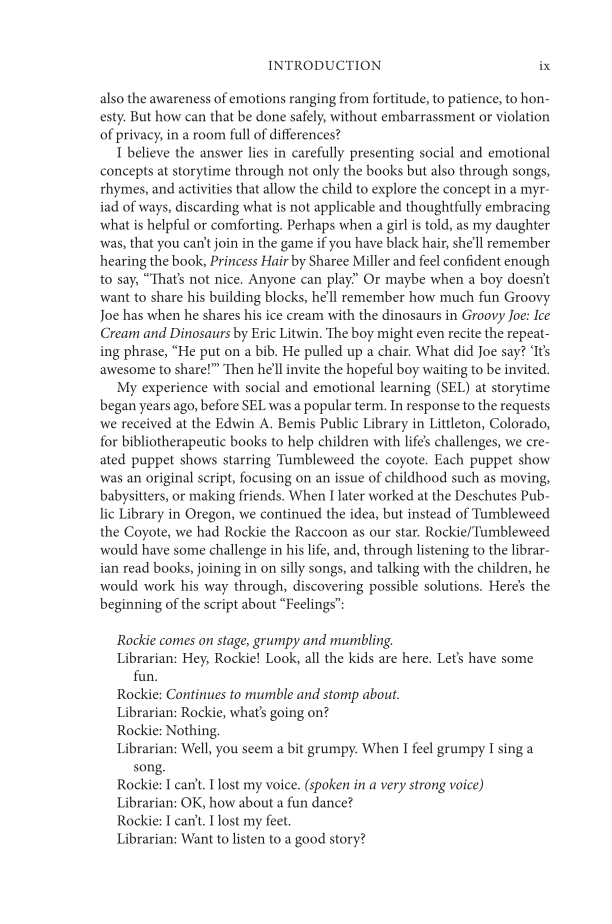Introduction ix also the awareness of emotions ranging from fortitude, to patience, to hon- esty. But how can that be done safely, without embarrassment or violation of privacy, in a room full of differences? I believe the answer lies in carefully presenting social and emotional concepts at storytime through not only the books but also through songs, rhymes, and activities that allow the child to explore the concept in a myr- iad of ways, discarding what is not applicable and thoughtfully embracing what is helpful or comforting. Perhaps when a girl is told, as my daughter was, that you can’t join in the game if you have black hair, she’ll remember hearing the book, Princess Hair by Sharee Miller and feel confident enough to say, “That’s not nice. Anyone can play.” Or maybe when a boy doesn’t want to share his building blocks, he’ll remember how much fun Groovy Joe has when he shares his ice cream with the dinosaurs in Groovy Joe: Ice Cream and Dinosaurs by Eric Litwin. The boy might even recite the repeat- ing phrase, “He put on a bib. He pulled up a chair. What did Joe say? ‘It’s awesome to share!’” Then he’ll invite the hopeful boy waiting to be invited. My experience with social and emotional learning (SEL) at storytime began years ago, before SEL was a popular term. In response to the requests we received at the Edwin A. Bemis Public Library in Littleton, Colorado, for bibliotherapeutic books to help children with life’s challenges, we cre- ated puppet shows starring Tumbleweed the coyote. Each puppet show was an original script, focusing on an issue of childhood such as moving, babysitters, or making friends. When I later worked at the Deschutes Pub- lic Library in Oregon, we continued the idea, but instead of Tumbleweed the Coyote, we had Rockie the Raccoon as our star. Rockie/Tumbleweed would have some challenge in his life, and, through listening to the librar- ian read books, joining in on silly songs, and talking with the children, he would work his way through, discovering possible solutions. Here’s the beginning of the script about “Feelings”: Rockie comes on stage, grumpy and mumbling. Librarian: Hey, Rockie! Look, all the kids are here. Let’s have some fun. Rockie: Continues to mumble and stomp about. Librarian: Rockie, what’s going on? Rockie: Nothing. Librarian: Well, you seem a bit grumpy. When I feel grumpy I sing a song. Rockie: I can’t. I lost my voice. (spoken in a very strong voice) Librarian: OK, how about a fun dance? Rockie: I can’t. I lost my feet. Librarian: Want to listen to a good story?
Document Details My Account Print multiple pages
Print
You have printed 0 times in the last 24 hours.
Your print count will reset on at .
You may print 0 more time(s) before then.
You may print a maximum of 0 pages at a time.







































































































































































































































